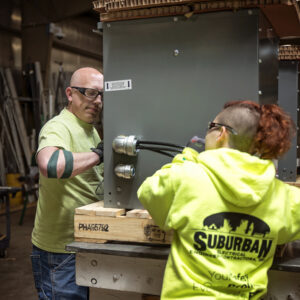If there is an electrical overload or faulty wiring in your home or business, or if lightning strikes during a storm, you may experience what is known as a power surge.
Fortunately, you can prevent damage that’s caused by a power surge by investing in a surge protector.
In this comprehensive guide, we’ll discuss what causes power surges and how surge protectors work to combat any potential damage. Additionally, we’ll provide information on the types of surge protectors available and what questions to ask your electrician to ensure that your electrical equipment is adequately protected.
What are Power Surges?
A power surge occurs when there are sudden increases in voltage on power lines or in electrical systems. They can happen for a variety of reasons:
- Lightning strikes
- Power outages
- Poor wiring
- Downed power lines
- Short circuits
- Switching on high-powered appliances
- Malfunctions at the power company
A power surge should be avoided as much as possible since it can cause significant damage to electronic devices and appliances. Even if a power surge only lasts a few nanoseconds, it can cause severe damage to your electrical equipment.
How Surge Protection Works
Protect your home, commercial business, or industrial building with surge protection device installation! At Suburban Electric, our residential and commercial electricians can install a surge protector to defend your devices and appliances against storms.
If you’re not already familiar with what a surge protector is, it’s essentially a device that diverts excess voltage away from the devices and into the ground. The surge protector does this by using a metal oxide varistor (MOV) to absorb excess voltage.
The MOV is a component that has a high resistance at normal voltage levels, but a low resistance at high voltage levels. When a power surge occurs, the excess voltage is directed to the MOV, which diverts it away from the protected devices.
The MOV absorbs the excess voltage and then directs it into the ground, which protects any devices or appliances that are connected to the surge protector. Learn more here about what is an electrical power surge and how they can be prevented.
Read More: When Should I Have Electrical Maintenance Performed?
Types of Surge Protectors
Now that you know what a surge protector is, let’s talk about the options that are available to you:
Power Strips
The simplest type of surge protector is the power strip, which features multiple outlets, providing surge protection for all devices plugged into it. It’s important to note that power strips offer only minimal protection from a power surge.
As a result, you should make sure that you check your device(s) specifications to ensure that your power strip can handle all voltage levels.
Point-of-Use Protector
If you want to protect individual electronic devices, you should consider using a point-of-use protector. Point-of-use protectors are simply plugged directly into the wall outlet to provide surge protection for a single device.
These protectors are ideal for protecting sensitive equipment such as computers and home theater systems.
Whole-House Surge Protectors
Lastly, if you’re looking for the most comprehensive protection against power surges, you should instead opt for the whole-house surge protector. This type of surge protector is installed in the main electrical panel of your home.
Whole-house surge protectors provide protection for all electrical devices and appliances which are connected to your home’s electrical wiring. It you have expensive or critical electronic equipment, then you need to choose this option.
Read More: 4 Electrical New Year’s Resolutions for Manufacturers
Questions to Ask Your Electrician About Surge Protection
If you are currently looking into choosing surge protection for your home or business, you’ll want to check with a trusted local electrical company.
Here are some questions to ask your electrician about surge protection and protective devices:
- Do I need surge protection for my home or office?
- What type of surge protector is best suited for my needs?
- Where should surge protectors be installed in my home or office?
- How often should surge protectors be replaced?
By asking these questions, you can be sure that your electrical equipment is adequately protected from power surges. Here are some other important questions to ask your electrician about your electrical service.
Contact Suburban Electric for Surge Protection Devices!
No matter if your surge protectors are aging and need to be replaced, or you are looking for a brand new device(s) and you’re weighing your options, the certified electricians at Suburban Enterprises can help.
We have decades of combined experience handling surge protection, machinery installation, EPM assessments, winterizing businesses, and more. We can also provide emergency 24/7 electrical services and routine service and support if needed.
With Suburban Electric, our team can help take out the headache and expense of sudden electrical failures, and can provide electrical repairs or perform a generator maintenance as needed. Contact our team for surge protection device installation or electrical maintenance today!
Read More: 5 Benefits of Hiring a Reputable Electrical Contractor


